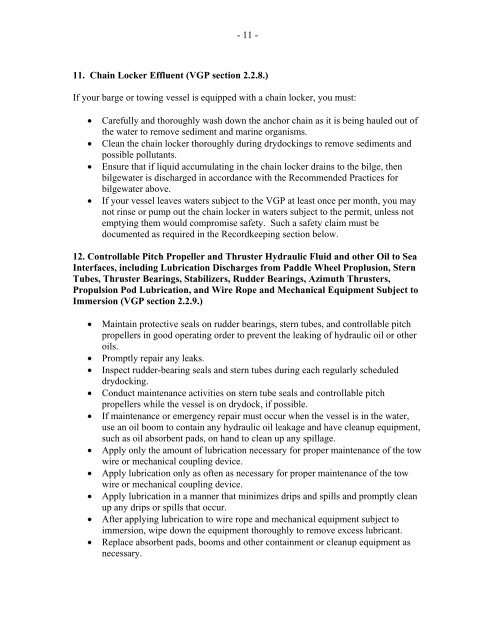AWO Recommended Practice Guide - The American Waterways ...
AWO Recommended Practice Guide - The American Waterways ...
AWO Recommended Practice Guide - The American Waterways ...
Create successful ePaper yourself
Turn your PDF publications into a flip-book with our unique Google optimized e-Paper software.
- 11 -11. Chain Locker Effluent (VGP section 2.2.8.)If your barge or towing vessel is equipped with a chain locker, you must:Carefully and thoroughly wash down the anchor chain as it is being hauled out ofthe water to remove sediment and marine organisms.Clean the chain locker thoroughly during drydockings to remove sediments andpossible pollutants.Ensure that if liquid accumulating in the chain locker drains to the bilge, thenbilgewater is discharged in accordance with the <strong>Recommended</strong> <strong>Practice</strong>s forbilgewater above.If your vessel leaves waters subject to the VGP at least once per month, you maynot rinse or pump out the chain locker in waters subject to the permit, unless notemptying them would compromise safety. Such a safety claim must bedocumented as required in the Recordkeeping section below.12. Controllable Pitch Propeller and Thruster Hydraulic Fluid and other Oil to SeaInterfaces, including Lubrication Discharges from Paddle Wheel Proplusion, SternTubes, Thruster Bearings, Stabilizers, Rudder Bearings, Azimuth Thrusters,Propulsion Pod Lubrication, and Wire Rope and Mechanical Equipment Subject toImmersion (VGP section 2.2.9.)Maintain protective seals on rudder bearings, stern tubes, and controllable pitchpropellers in good operating order to prevent the leaking of hydraulic oil or otheroils.Promptly repair any leaks.Inspect rudder-bearing seals and stern tubes during each regularly scheduleddrydocking.Conduct maintenance activities on stern tube seals and controllable pitchpropellers while the vessel is on drydock, if possible.If maintenance or emergency repair must occur when the vessel is in the water,use an oil boom to contain any hydraulic oil leakage and have cleanup equipment,such as oil absorbent pads, on hand to clean up any spillage.Apply only the amount of lubrication necessary for proper maintenance of the towwire or mechanical coupling device.Apply lubrication only as often as necessary for proper maintenance of the towwire or mechanical coupling device.Apply lubrication in a manner that minimizes drips and spills and promptly cleanup any drips or spills that occur.After applying lubrication to wire rope and mechanical equipment subject toimmersion, wipe down the equipment thoroughly to remove excess lubricant.Replace absorbent pads, booms and other containment or cleanup equipment asnecessary.















